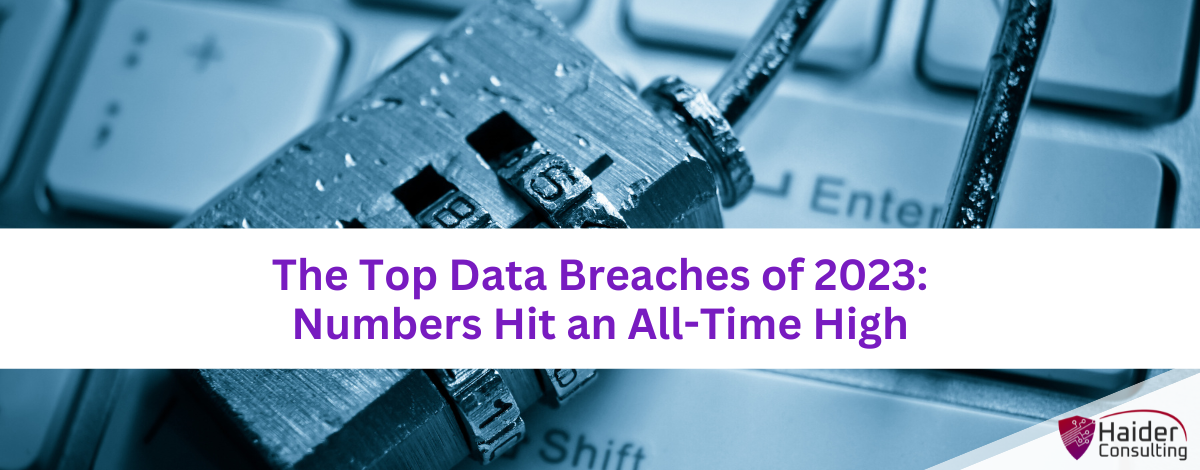As we reflect on 2023, it stands out as a critical year in the cyber realm, marking a significant rise in data breaches and intensifying the cybersecurity battleground. Data compromises in the U.S. have soared, surpassing previous records and underscoring an urgent need for businesses to bolster their cyber defenses. Let’s dissect this surge in cyber threats and explore strategic measures to shield your business.
Analyzing the Surge in Cybersecurity Incidents in 2023
By the end of Q3, 2023, the top known data compromises were:
- HCA Healthcare
- Maximus
- The Freecycle Network
- IBM Consulting
- CareSource
- Duolingo
- Tampa General Hospital
- PH Tech
But the rest of the year hasn’t been reported yet. Still, with 2023 being a record breaking year for data breaches, we need to take a look at the key drivers for this increase, and the urgent need for better cyber security measures.
Here’s some of the highlights from the last year:
1. Unprecedented Spike in Data Breaches
The landscape of cyber threats has seen a major increase, with over 2,100 data compromises reported by September 2023. Even without the full year of data, this is already the most reported breaches in a year, crushing the 2021 record of 1,862 organizations breached. This alarming trend highlights the increasing sophistication of cyber threats and the growing challenge for organizations in protecting their digital assets.
2. Targeted Attacks on the Healthcare Sector
The healthcare industry, a repository of sensitive patient data, has become a hotspot for cyber-criminals. Breaches in this sector not only compromise patient privacy but also threaten the integrity of vital medical records, potentially leading to far-reaching consequences. Unfortunately, all of these factors make ransomware and extortion payments to cyber-criminals all the more likely, which means that healthcare is a prime target for criminals seeking a fast payout.
3. The Dominance of Ransomware Attacks
Speaking of ransomware, this method continues to reign as a primary cyber threat, with attackers leveraging encryption as a weapon. And in recent attacks, even if organizations are able to restore their files, cyber-criminals are extorting their victims, threatening to publish the records they accessed, causing a far more serious breach. These evolving tactics, aimed at locking critical data and demanding ransom, underscore the necessity for businesses to enhance their incident response strategies.
4. Supply Chain Vulnerabilities
Modern business are incredibly interconnected, and this makes their supply chain a great way to attack. Vulnerabilities in this ecosystem can often trigger a domino effect, hitting multiple businesses in one single hack. All of these factors only emphasize the need for comprehensive security strategies that cover all networked businesses.
5. The Hidden Danger of Insider Threats
While external risks usually get the front seat in media attention, the rise in insider threats adds complexity to the cyber security equation. Whether it’s from an angry employee or a negligent one, it’s important to make sure threats from within the company are secured. But distinguishing between legitimate activities and potential insider risks is becoming an essential, yet challenging, aspect of cyber defense.
6. IoT Devices: The New Frontline
The increase of Internet of Things (IoT) devices has broadened the cyber attack surface. With things like smart fridges, smart watches, and even things like industrial controllers, all living on the network, hackers are finding a much wider range of devices to break into networks with. Incidents from compromised IoT devices highlight the critical need for enhanced security measures for these increasingly common devices.
7. Critical Infrastructure Under Attack
Cyber attacks on critical infrastructure sectors pose risks that go beyond financial loss, extending to public safety and national security. This unfortunately also makes them prime targets for things like ransomware, since keeping these facilities running is so important. So protecting these essential services from cyber threats is becoming a paramount concern, especially with rising tensions globally.
8. Nation-State Actors and Hacking
Geopolitical dynamics are increasingly influencing the cyber threat landscape, with nation-state actors engaging in sophisticated campaigns driven by political objectives. These actors use advanced tactics that basic security methods struggle to detect, posing significant challenges to data security and operational stability.
9. Redefining Cybersecurity Approaches
The sharp increase in cyber incidents underscores the imperative to evolve cybersecurity strategies. These days, it’s no longer a question of if an organization will be targeted, but when. Because of this, adopting robust frameworks, continuous monitoring, and fostering a culture of cyber awareness are key to mitigating the risks of sophisticated cyber threats.
10. The Power of Collaboration
In facing these advanced threats, collaboration and intelligence sharing within the cyber security community are vital. As threats become more and more sophisticated, so does the need for greater collaboration in our cyber defenses. By pooling insights and defense strategies, businesses can collectively strengthen their protection against shared cyber adversaries.
Safeguarding Your Business in the Face of Cyber Adversity
The record-breaking cyber incidents of 2023 serve as a clarion call for businesses to reevaluate and fortify their cybersecurity posture. Navigating this complex landscape demands heightened vigilance, advanced protective measures, and agility to counter the tactics of ever-evolving cyber adversaries.
In need of expert guidance to secure your business against these daunting challenges? Reach out to us for a strategic consultation and ensure your enterprise stands resilient in this new era of cyber threats.
Book My 17-Minute Call





